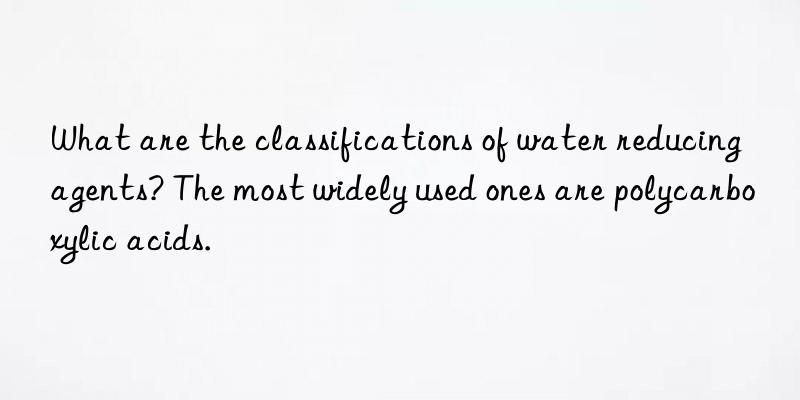
Water-reducing admixture refers to an admixture that can reduce the amount of mixing water and increase the strength of concrete while maintaining the workability and cement dosage of the concrete. Or it can save the cement dosage while maintaining the workability and strength. With the development of high-performance concrete technology, especially in the future, concrete must not only have high performance, but also must develop in the direction of sustainable development that is green and harmonious with the environment. As the third generation water-reducing agent, polycarboxylic acid-based water-reducing agent has been widely recognized at home and abroad due to its irreplaceable advantages in high-performance concrete and its environmentally friendly characteristics.
The feasibility of applying polycarboxylic acid water-reducing admixture to ready-mixed concrete. Combined with the actual cases of enterprise application, the effects of polycarboxylic acid-based water-reducing agents and naphthalene-based water-reducing agents on concrete properties were compared, and the comparisons were made from aspects such as slump maintenance, compressive strength ratio, and volume stability, and comprehensive evaluation was carried out. Advantages and disadvantages, feasibility is established
The main functions of water-reducing agents are as follows: increasing hydration efficiency, reducing unit water consumption, increasing strength, saving cement consumption; improving the ease of concrete that has not yet solidified. properties to prevent the segregation of concrete components; improve impermeability, reduce water permeability, avoid leakage of concrete building structures, increase durability, and increase chemical corrosion resistance; reduce the shrinkage rate of concrete solidification, prevent cracks in concrete components; improve frost resistance properties, which is conducive to winter construction.
In the preparation process of concrete, mortar and paste, a small amount (not exceeding 5% of the cement dosage) is added into a product that can change the properties of concrete, mortar or paste, which is called concrete Admixtures.
Adding an appropriate amount of admixtures to concrete can improve concrete quality, improve concrete properties, reduce concrete water consumption, save cement, reduce costs, and speed up construction progress. With the advancement of technology, admixtures have become the fifth essential material besides cement, coarse and fine aggregates, admixtures and water. Adding admixtures is an important measure to optimize the design of concrete mix proportions and improve the durability of concrete. . Therefore, the newly revised "Hydraulic Concrete Construction Specifications" (DL/T5144-2001) emphasizes that an appropriate amount of admixtures must be added to hydraulic concrete.
So what types of water reducing agents are there?
1. Lignosulfonate: It is an ordinary water reducing agent. Its raw material is lignin, which is usually obtained from coniferous trees. Extracted from wood, lignin is polymerized from three lignin monomers: p-apergenol, coniferyl alcohol, and sinapyl alcohol. It can be used in mortar to improve workability, fluidity, strength, and water reduction rate of 5%. -10%.
2. Naphthalene sulfonate water-reducing agent: It is the earliest used in China. It is the product of naphthalene sulfonation through sulfuric acid and then condensation with formaldehyde. It is an anionic surfactant. The appearance of similar water-reducing agents can be light yellow to dark brown powder depending on the product. It is easily soluble in water and has good dispersion effect on many powder materials such as cement. The water reduction rate can reach 25%.
3 . Melamine water-reducing agent: It is the product of melamine sulfonated with sulfuric acid and then condensed with formaldehyde. Therefore, the chemical name is sulfonated melamine-formaldehyde resin, which is an anionic surfactant. This type of water-reducing agent appears as white powder and is easy to use. It is soluble in water, has good dispersion of powder materials, has a high water-reducing rate, and has good fluidity and self-healing properties.
4. Powder polycarboxylate: It is a new type of water-reducing agent developed. It has excellent water reduction rate, fluidity and permeability. It significantly enhances the strength of cement mortar, but the production process is complicated and the price is generally higher.
5. Casein: It is a biopolymer , it is obtained after milk is precipitated with acid and dried in a cylinder.
6. Polycarboxylate water-reducing agent is currently the most cutting-edge in the world, with the highest scientific and technological content, the best application prospects, and the best comprehensive performance. An excellent concrete superplasticizer (water-reducing agent). Polycarboxylate water-reducing agent is a compound product of carboxylic acid graft multi-copolymer and other effective additives. Performance comparison with similar products at home and abroad shows that The polycarboxylate water-reducing agent has reached the current international advanced level in terms of technical performance indicators and cost-effectiveness.
</p



 微信扫一扫打赏
微信扫一扫打赏
